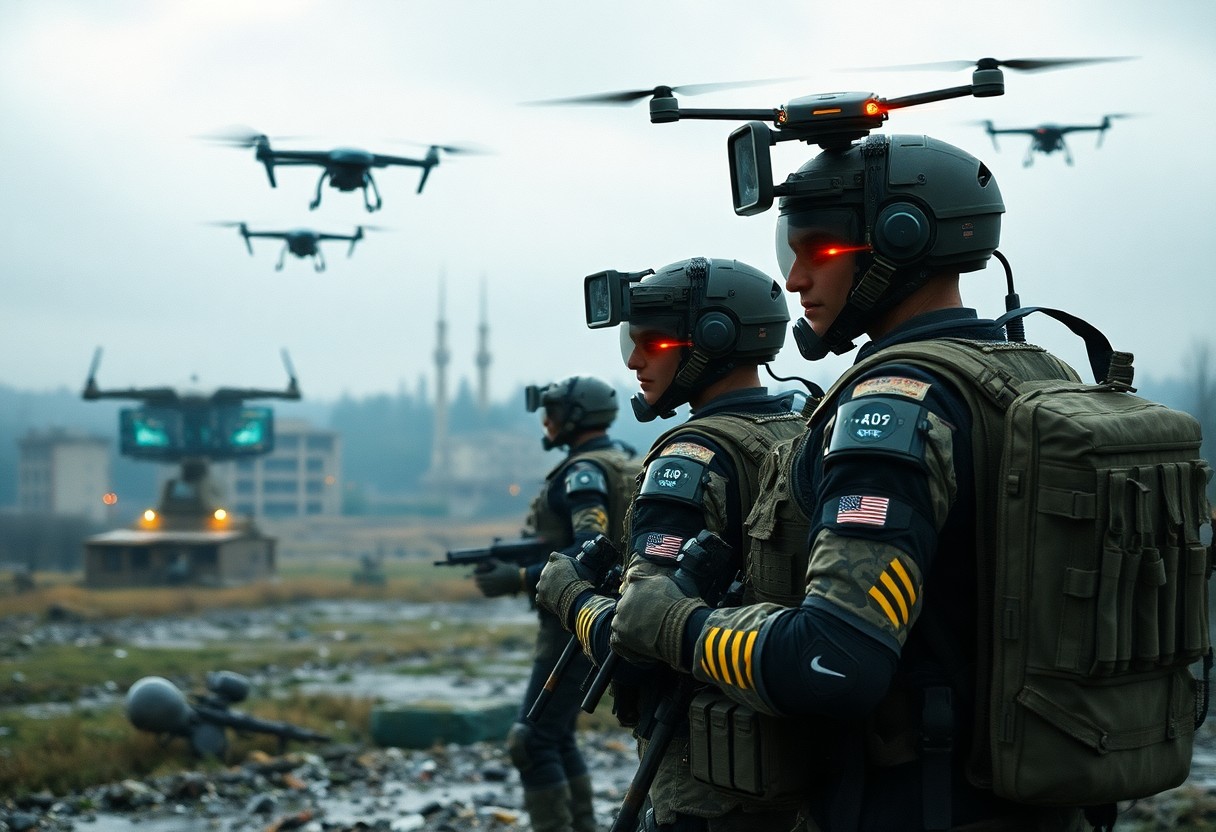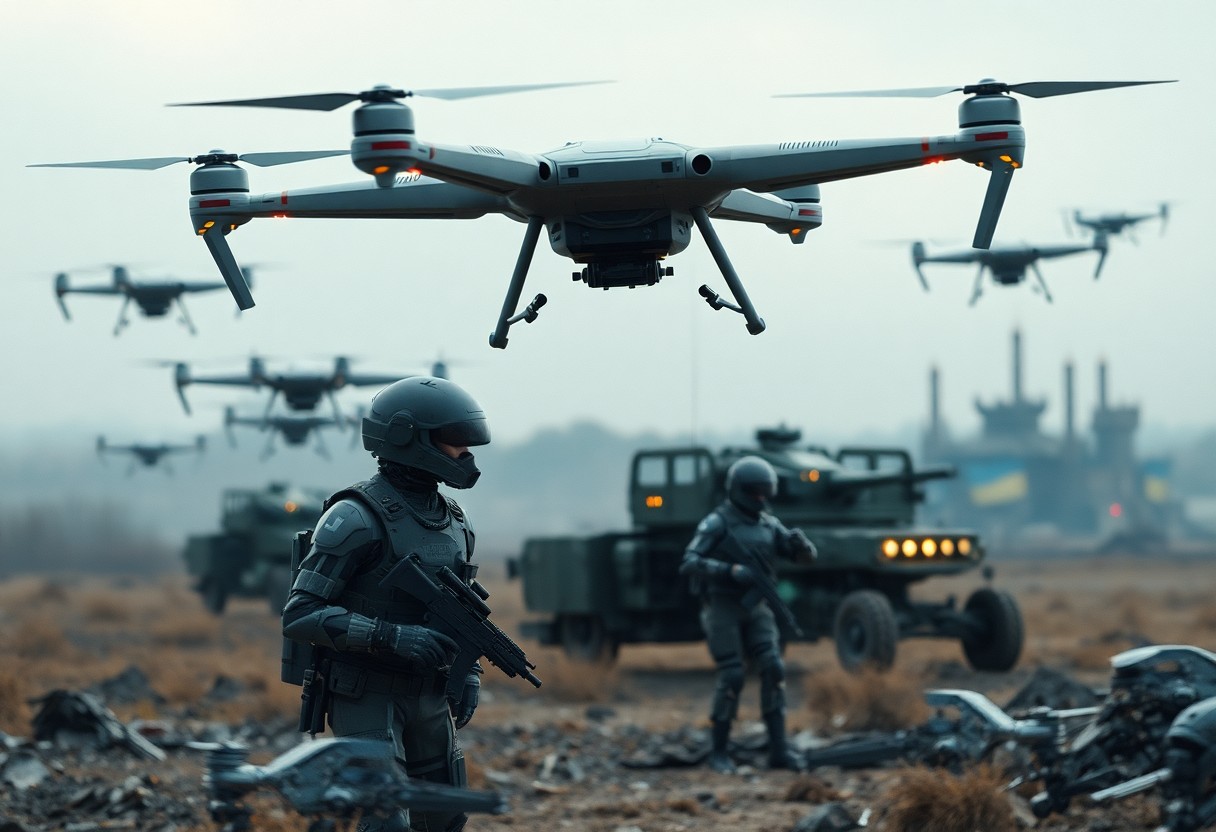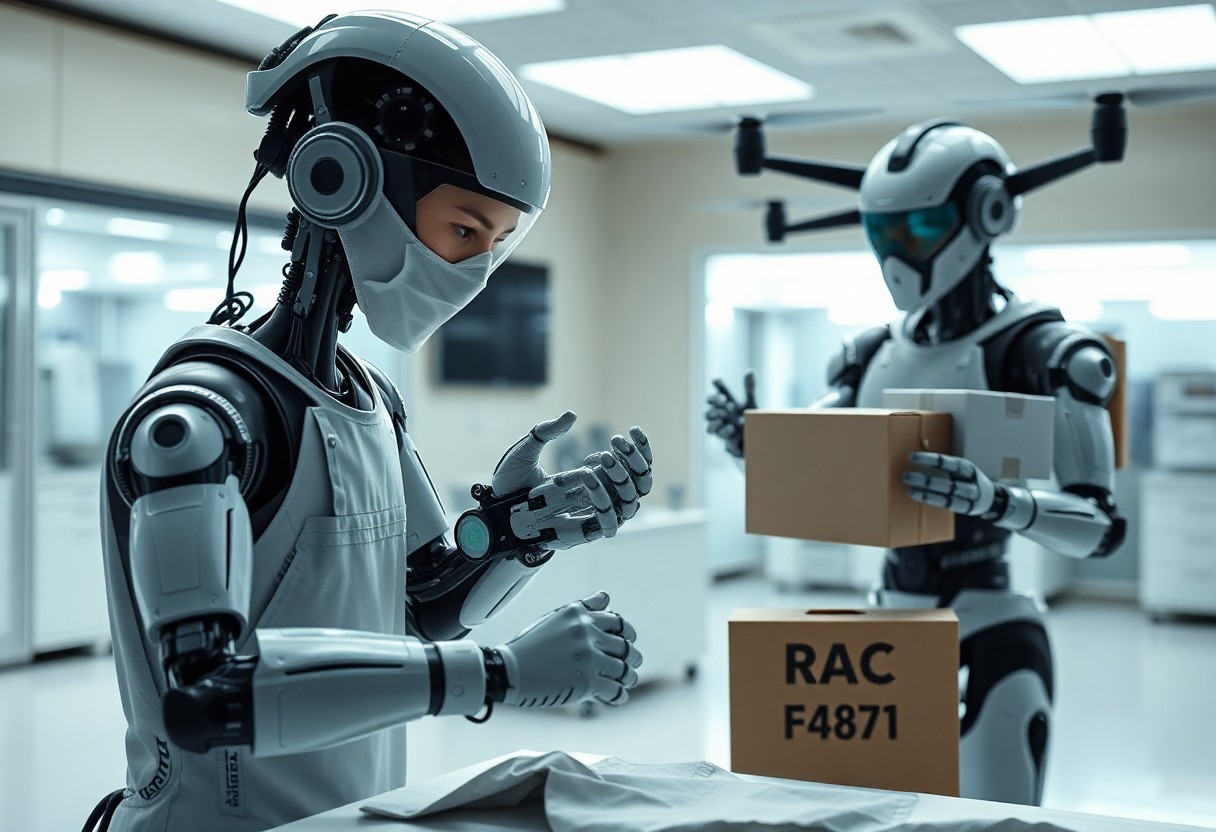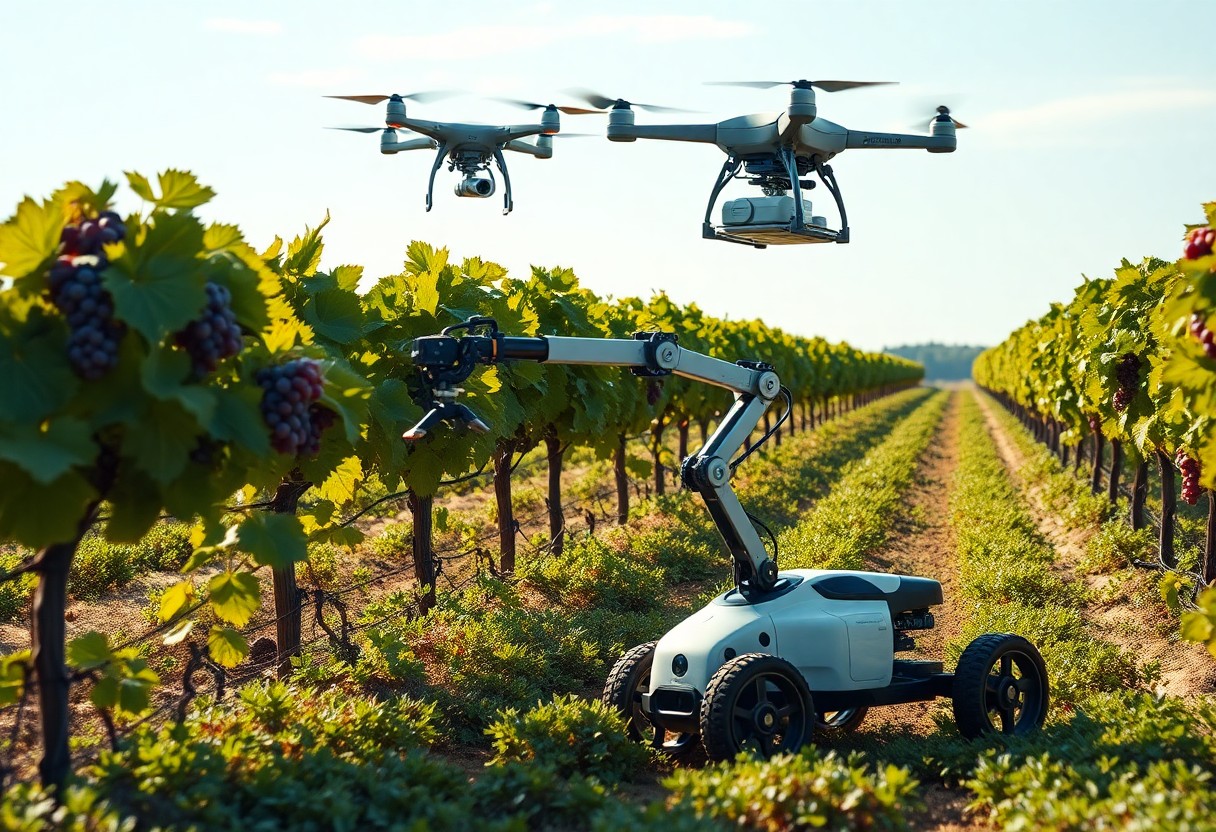Many experts believe that the increasing use of robotics in warfare could significantly alter the narrative surrounding the Ukraine conflict. As you explore into this topic, you will explore how advancements in unmanned systems, drones, and AI-driven technologies are reshaping military strategies and humanitarian efforts. By examining the implications of these innovations, you’ll gain insight into how they might influence public perception and geopolitical dynamics, ultimately transforming the way you understand modern warfare in the context of Ukraine.
Drones and Digital Warfare: A Tactical Revolution
The integration of drones into the Ukraine conflict has sparked a tactical revolution, reshaping how battles are fought and won. Unmanned aerial vehicles (UAVs) have not only enhanced reconnaissance capabilities but have also opened new avenues for direct engagement, allowing for precise strikes from a safe distance. This shift is redefining how military operations are planned and executed, with real-time data feeding into decision-making processes that enable rapid, informed responses to evolving situations on the ground.
The Rise of Autonomous Drones in the Conflict
Your observations will reveal that autonomous drones have emerged as formidable players in the Ukraine conflict, performing both surveillance and strike missions with minimal human intervention. These UAVs leverage sophisticated AI algorithms to identify targets, navigate complex environments, and adapt to changing battlefield conditions, all while reducing the risks to human operators. Notably, Ukraine’s use of systems like the Bayraktar TB2 has showcased how drones can sway operational outcomes significantly.
Impact on Ground Operations and Strategic Decisions
Autonomous drones are fundamentally altering ground operations and the strategic landscape of the conflict, offering unprecedented advantages in intelligence and engagement. You’ve likely noted how they allow for real-time battlefield assessments that inform tactical decisions, enabling commanders to deploy forces more effectively. This ability to gather and disseminate information at lightning speed shifts combat dynamics, as military units can react more quickly to threats or opportunities, minimizing exposure to enemy fire.
With the deployment of drones, you might observe shifts in traditional ground maneuvers, as commanders increasingly rely on data-driven decisions. Real-time intelligence allows for better allocation of resources and troops, preventing bottlenecks and overextensions. For instance, if your drones detect a concentration of enemy forces, you could launch targeted strikes, thereby neutralizing threats before they can launch an offensive. As engagements become more information-centric, maintaining situational awareness through drone surveillance becomes imperative to mitigate risks and gain tactical advantages over adversaries.
Shaping Public Perception: The Role of Robotics in Media Coverage
Robotics in warfare not only impacts the battlefield but also shapes how media portrays the conflict. Images and videos of drones, autonomous vehicles, and robotic soldiers instantly resonate, creating emotional connections with audiences. As you engage with these visuals, you might find that the portrayal of warfare shifts from traditional narratives of human soldiers to the cold efficiency of machines, leading to a complex understanding of the war’s motivations and outcomes.
How Robotics Alter the Narrative of War
By replacing traditional combat narratives with technological advancements, robotics redefine how conflicts are perceived. The focus on machines enhances the representation of war as a series of algorithms and data points rather than human sacrifice and heroism. This shift invites you to reconsider the implications of warfare, leading to discussions on ethical responsibilities and military accountability in an era dominated by artificial intelligence.
The Influence of Social Media on Robotics Imagery
Social media acts as a powerful amplifier for robotics imagery in the context of warfare. Platforms like Twitter and Instagram allow for the rapid dissemination of drone footage and robotic combat scenarios. This immediacy influences your understanding of the war, as sensational images circulate quickly and often devoid of context, skewing your perceptions and feeding into polarized narratives.
The emergence of robotics imagery on social media not only captures your attention but also plays a significant role in shaping public opinion. For instance, viral drone footage showing precision strikes may evoke admiration for technological prowess while simultaneously downplaying the human cost of conflict. As you scroll through these images, consider the narrative techniques employed—hashtags, memes, and user-generated content often emphasize certain aspects of warfare, potentially skewing your understanding and influencing your emotional response. With robotics at the forefront, the lines between fact and perception blur, creating an environment where your views on war are increasingly shaped by the rapid flow of digital content.
Ethical Considerations: Navigating the Moral Landscape
The complexities of integrating robotics into warfare raise significant ethical questions. As you probe into the implications of autonomous systems on decision-making in combat, you must consider the potential loss of human judgment. These technologies challenge traditional warfare ethics, compelling you to reflect on the distinction between man and machine, and the moral responsibilities that accompany lethal action.
The Debate Over Autonomous Warfare
As discussions around autonomous warfare intensify, proponents argue that such systems could minimize human error and potential soldier casualties. However, you might find critics expressing concern over the inability to hold machines accountable for decisions that lead to loss of life. This debate invites you to ponder whether machines should ever have the autonomy to engage decisively in conflict.
Human Cost and the Role of Accountability
The ramifications of using robots in warfare also manifest in the human cost associated with armed conflict. You are faced with the challenge of balancing technological advancement and the preservation of human dignity. The shifting accountability landscape becomes paramount; if autonomous systems make fatal errors, you must grapple with who is ultimately responsible—the operators, programmers, or the machines themselves?
As the consequences of robotic warfare become clearer, you should assess the implications for accountability in military engagements. In 2020, a study noted that over 75% of military leaders expressed unease about accountability when employing autonomous systems. This tension raises profound questions about ethical governance and the necessity for regulations that ensure human oversight remains a cornerstone of warfare. Without accountability mechanisms, you risk undermining public trust in military operations and potentially dehumanizing conflicts further. The conversations around these issues not only inform future policies but also shape the way societies perceive the development of military technology.

Future Prospects: Robotics as a Game-Changer in War Tactics
The integration of robotics into military strategies has the potential to dramatically reshape battlefield dynamics. As drones, automated vehicles, and AI-powered systems gain prevalence, you will see a shift not only in how combat is conducted but also in resource allocation and troop safety. Enhanced reconnaissance, precision strikes, and logistical support through robotics might minimize human casualties while maximizing operational efficiency. The future landscape of warfare could ultimately become unrecognizable as robotics continues to develop and evolve.
Potential Innovations on the Battlefield
Innovations such as swarm robotics and autonomous combat units are on the horizon, promising to revolutionize warfare. Imagine battalions of drones operating in synchronized formations, capable of overwhelming enemy sensors and defenses with sheer numbers. You’ll also witness advancements in AI-driven decision-making, allowing for real-time adaptive strategies. These technologies could redefine traditional combat methods, making them faster and more lethal, while also increasing the uncertainty for your opponent’s strategic planning.
Predictions for Long-term Strategic Outcomes
Looking ahead, you can anticipate a landscape where robotics dominates warfare, creating both challenges and opportunities. Nations investing heavily in robotic technologies may achieve a significant strategic advantage, leading to an arms race in automation. The reliance on robotics could also alter alliances and treaties as countries align based on technological capabilities rather than traditional military strengths. Adapting to these new elements will be crucial for understanding the future of global conflict.
As robotics evolve, you should expect a redefined set of geopolitical strategies influenced by the balance of technological power. The potential for autonomous systems to conduct operations without direct human oversight may prompt ethical debates, international regulations, and new frameworks for engagement. Warfare could shift towards more asymmetric tactics, where nations with advanced robotics counteract traditional forces through unpredictability and innovation. This transformative phase could ultimately lead to a paradigm where military prowess is less about numbers and more about technological capabilities and their strategic application.
Human-Technology Collaboration: The New Face of War
The modern battlefield thrives on the synergy between human soldiers and autonomous machines, transforming strategies and tactics. This collaboration enhances operational effectiveness, providing real-time intelligence and minimizing human risk. As warfare evolves, your understanding of these interactions becomes crucial, as they redefine command structures and the very concept of combat itself, focusing on complementing human judgment with robotic efficiency.
The Importance of Human Oversight in Robotics
Human oversight remains pivotal as these robotic systems take on more responsibilities. You must consider the ethical implications and decision-making involved. Soldiers and commanders are needed to interpret complex situations that machines cannot fully grasp, ensuring accountability and ethical judgment in warfare. Without your involvement, the potential hazards of autonomous operations loom large, highlighting the necessity for human intervention.
Integrating Advanced Robotics into Military Training
Incorporating advanced robotics into military training programs equips personnel with the skills to effectively utilize these technologies. This integration fosters adaptability and strategic thinking, crucial for operating in an increasingly automated environment. Exposure to robotic systems during training allows you to understand their capabilities and limitations, ensuring that your approach to combat remains both innovative and grounded in reality.
- Simulation scenarios with robotic assistance
- Workshops on ethical use of autonomous systems
- Evaluation of human-robot interaction
| Training Components | Benefits |
|---|---|
| Hands-on experience with drone operations | Enhances real-world competency in drone applications |
| Scenario-based training with AI decision-making | Improves strategic adaptability under pressure |
| Collaboration drills between human teams and robotic units | Increases teamwork and understanding of robot capabilities |
Training programs now often include simulated environments where robotic systems are part of conflict scenarios. You will be engaged in mastering these interactions, ensuring that you’re not just a passive participant but an active operator of these advanced technologies. As you practice, the boundaries between human oversight and machine efficiency become clearer, enabling you to develop strategies that fully leverage the potential of robotics in combat.
- Enhanced battlefield simulation
- Real-time decision-making exercises
- Feedback loops for evaluating robotic performance
| Assessment Techniques | Outcome Focus |
|---|---|
| Performance reviews during drills | Identifying areas for improvement |
| Post-scenario evaluations with robotic technologies | Strategizing future tactics based on outcomes |
Summing up
To wrap up, the integration of robotics into the Ukraine war narrative promises to reshape not only tactical operations but also public perception and discourse. As you observe advancements in robotic technology and their application in military contexts, consider how these innovations may influence your understanding of warfare dynamics and decision-making processes. The potential for a paradigm shift in your perception of conflict is significant, as robotics could redefine traditional roles, ethics, and humanitarian considerations in modern warfare.







